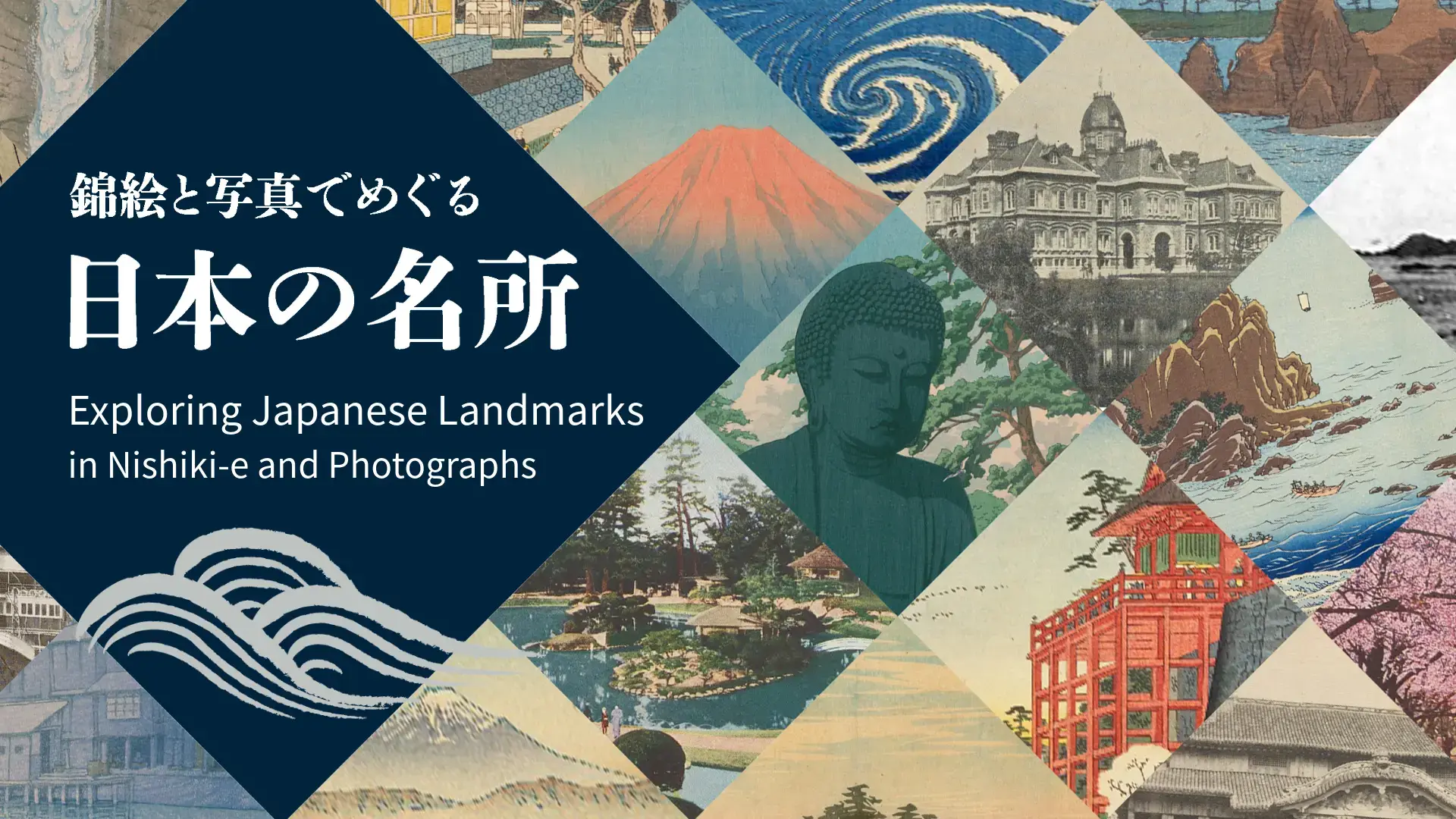
明治時代の芝居と劇場
このコラムは、平成19年に電子展示会「写真の中の明治・大正」の中で公開したコラムを移行したものです。内容は当時の記載内容に基づきます。
新富座/守田勘弥の欧化熱
天保改革以来、浅草近傍に集められていた江戸三座(市村座、中村座、森田座)と呼ばれる官許の芝居小屋のうち、明治5(1872)年に、京橋区新富町(現中央区新富)に進出したのが新富座(同8年まで守田座=森田座)である。9(1876)年に焼失、同11年に再建の際は、一部に椅子席を設置、ガス灯を導入し、6月7日の開場式には在京の外国人を招待するなど、文明開化に相応しい雰囲気の芝居小屋を演出した。
その時招待された英国公使館員トーマス・マックラッチは、「日本には浪人という者が長い刀をさしていて、外国人を見ればすぐに斬る」と心配されて赴任したにも関わらず、綺麗な劇場で美しい芝居を見物できたことを喜び、母国の母や友人に詳しく手紙に書いたという。そして、自ら尽力して外国人一同で新富座に贈り物をすることになった。なかだちになったのは、英国公使館に勤めており、九世市川団十郎と親交のあった岡本純(敬之助)。劇作家岡本綺堂の父である。12(1879)年2月3日に、紫緞子地(むらさきどんすぢ)に松竹梅と勘弥の定紋(じょうもん)「かたばみ」が描かれ、「守田氏江」「在東京外国人中」と記された引幕が贈られると、座主守田勘弥は「現今の光栄、後代の面目」と喜び、28日からの3月興行には早速その引幕を用いたのである。
新富座は、この年7月16日に、グラント前アメリカ合衆国大統領を迎える。このときも、入口に六反がけの日米両国の国旗を掛け、表の通り舞台上も両国の国旗を飾ったほか、フィナーレは芸者70名余による踊りであり、衣装は赤白の横筋の着物に、その下は藍地に白の星を染め出した襦袢(じゅばん)の揃いという扮装で星条旗に擬えるという、いささか奇抜ともいえるほど華やかな演出を企画したという。
どうやら、守田勘弥は、随分モダンな人物だったようである。12(1879)年3月、父を訪ねて来た勘弥に会った岡本綺堂は、「守田が土産に持って来たのは、西洋菓子の大きい折で、風月堂で買ってきたのであった。明治十二年頃に西洋菓子など持ちあるいているのは、よほど文明開化の人間」と回想している。
だが、この奇抜さが裏目に出たのは、この年9月の興行であった。なんと英国人の俳優8人を起用したのである(『源平布引滝・漂流奇譚西洋劇』)。しかし、台詞の通じない外国人はやはり無理があったようで、「西洋人の狂言に至ては珍紛漢紛にて一切解らず」、女優の声は「丁度洋犬の吠ると一般訴ふるが如く泣が如く」で、「見物多くハ徹頭徹尾一切解らず只只大笑絶倒せり」という有様で、勘弥は多額の負債を抱えることになった。
この興行の失敗で、勘弥の欧化熱は冷めるといわれるが、その後も新富座は一流の役者を擁し、「日本一の劇場」として繁栄を続け、22(1889)年落成の歌舞伎座と覇を競うことになる。その界隈も、鏑木清方によれば「築地橋の角から桜橋の方へ行った四つ辻まで芝居のならび、向側に、芝居茶屋が軒を並べて、(中略)芝居小屋を中心にして、全く一廓別天地の芝居町を形づくって、はなやかな雰囲気を生じていた」のである。
歌舞伎座/新富町時代から木挽町時代
福地桜痴(源一郎)らが計画し、かねてより評判となっていた「改良演劇場」を、京橋区木挽町3丁目(現中央区銀座)に設立する許可が下りたと報じられたのは明治21(1888)年8月31日のことであった。9月18日の読売新聞には、劇場の名も「歌舞座」と報じられる。この「歌舞座」には、「かぶ座といって大根を列べられては困る」(岡本綺堂『ランプの下にて』)というような戯言もあったそうで、まさかそのためとも思われないが、新劇場の名称は「歌舞伎座」に落ち着く。
新富座の守田勘弥にとって、眼と鼻の先に大劇場ができることは大打撃である。「芝居道のビスマーク」こと勘弥は策を廻らした。「歌舞座」記事の翌19日の読売新聞によれば、新富、市村、中村、千歳四座が大同団結して興行を行うこととして、早速、準備が整っていた新富座の9月興行を千歳座に譲り、団菊左3名優(九世市川団十郎、五世尾上菊五郎、初世市川左団次)がそれぞれ5役、5役、7役と勤めることを報じている。さらに、四座は、団菊左はじめ在京の主な役者に、22(1889)年1月から向こう5年間、四座以外の劇場に出勤しない契約を結ばせたのであった。
歌舞伎座の桜痴は11月の舞台開きに向けて団十郎、菊五郎ら各個の切り崩しを狙うが、失敗。桜痴は自ら白粉をつけて舞台に上がるとまで言い出したという。岡本綺堂によれば、町には「劇場は落成しても早速に開場は覚束ない」とも「四座団結が切崩されて、某俳優は已に出勤の内役が整った」とも噂がかまびすしく飛び交っていた模様である。綺堂自身「この小屋は折角出来あがっても結局どうなることであろうと、何だか気の毒」と思っていた。だが、10月末になると、歌舞伎座の舞台開きに、団菊左3名優が揃って出演することが発表される。これは、井上馨が間に入り、歌舞伎座の金主千葉勝五郎から守田勘弥に示談金と新富座維持費計20,000円を支払うことで、落着したものであった
完成した歌舞伎座は間口15間、奥行30間。450坪強。外見は洋風クラシック式で漆喰の壁上には楽器の絵が塗出され、外廓は煉瓦が積まれている。内部は日本風の3階建てで、すべて無節の檜材が使われた。土間天井にはシャンデリアも付けられていた。見物場は13間に10間の広さ。土間、高土間、鶉の数はすべて225区、2階、3階の桟敷はそれぞれ80区、3000から3500人を収容する広壮な劇場であった。「今までは新富町の新富座が東京第一、即ち日本第一の大劇場と認められていたのであるが、それとこれとは殆ど比較にもならないほどの大建物を見せられて、誰も彼もみな驚かされた」(岡本綺堂[他]『風俗明治東京物語』)のであった。
この後、歌舞伎座が団十郎一世一代の「道成寺」(23年3月)、風船乗スペンサーに扮した菊五郎が英語で演説する「風船乗評判(うわさの)高閣(たかどの)」(福田熊治郎 刊) (長谷川園吉 刊)」(24年1月)などの大入に恵まれれば、新富座は「め組の喧嘩」(「神明恵和合取組(かみのめぐみわごうのとりくみ)」23年3月)や彰義隊の芝居「皐月晴上野朝風」(23年5月)等で評判を取る。両座同日に開幕したり、東上した売出し中の中村鴈治郎を奪いあうなど、競い合って興行をつづけた。綺堂によれば、新富座の方が華やかな人気が集まっており、歌舞伎座は寂しく感じられたそうである。だが新富座は、次第に多額の負債に圧迫されるようになり、歌舞伎座の独天下となっていく。そして、このことは、44(1911)年、新たな強敵となる帝国劇場の登場まで続くのである。
演劇改良運動と「国立劇場」の建設論
明治19(1886)年、イギリスから帰国した末松謙澄は、「猥褻野鄙」な日本の演劇を改良し、「学者名士」の脚本により「優美高尚の趣」を持たせ、劇場を社交場とすることを主張して、演劇改良会を結成した。時は鹿鳴館時代。政府も条約改正の道具と考え、伊藤博文、井上馨、西園寺公望、渋沢栄一など政財界の大物が参加した。
末松の改良論は具体的である。『演劇改良意見』によれば、劇場は3階建の煉瓦石造とし椅子席を配置。幕間に茶や酒を飲む芝居茶屋は廃止して休憩室を置く。花道は無くともよく、チョボ(義太夫語り)は廃止。幕間の物売も全廃して「西洋の通り幕の間はマルで音楽ばかり奏して人の心を清く鎮め」る。その音楽も「三味線鼓でドンチャンポンポンやられては困り者」なので、「西洋の音楽なら極めてよろしい」と、いささか過激である。女優養成や、脚本の筋や台詞にも意見を示し、とどまる所を知らない。
この改良論は実現しなかったが、演劇改良会員であった福地桜痴らにより、現実的な形で建設されたのが歌舞伎座であった。桜痴は改良芝居の脚本作成にも奮闘した。また、市川団十郎の熱意は格別で、「何事にも改良」という時代でもあり、盛んに改良芝居が喧伝された。だが、全体としては、掛声の割に「学者側の議論家も、口で改良を唱えても、(中略)理屈を盛んに述べているに過ぎないし、(中略)旧劇の方では、歯牙にもかけていなかった」(篠田鉱造『明治百話』)ともいわれる。岡本綺堂も「知識階級に喜ばれるような狂言では一般の観客が来ない。したがって昔ながらのお家騒動や白浪物でお茶を濁して」おり、はかばかしい改良も進歩も見えずにいたと回想した。
時は移って日露戦争後、外国の賓客の来訪が増え、しかるべき大集会堂や娯楽場を選定するのに少なからず当惑したことなどから、改良論は国立劇場の建設論に形を変えて、再び盛り上がりを見せる。斎藤信策(高山樗牛の弟)「国立劇場と紀念像とを建設せよ」、上田敏「国立劇場の話」等の理念的な主張から、「窮屈なる紅葉館に口に適せざる日本料理を饗せられ、怪し気なる手踊をみせられ」た「外国の貴賓或ハ名士」は、「茫然」とするだろうという新聞社説まであった(読売新聞 38年10月19日付朝刊)。
こうしたなか、国立ではないものの、44(1911)年、ルネサンス式の外観を持つ帝国劇場が建てられる。この帝国劇場は、まさに、末松や演劇改良論者の望んだ西洋式の劇場に他ならなかった。
引用・参考文献
- 読売新聞 【YB-41】
- 伊原敏郎『歌舞伎年表.第7巻(安政元年-明治31年)』岩波書店,1962 【774.032-I157k-K】
- 上田敏「国立劇場の話」『文芸講話』金尾文淵堂,明治40(1907) 【74-360】
- 岡本綺堂『ランプの下にて:明治劇談』(岩波文庫)岩波書店,1993 【KD487-E43】
- 岡本綺堂,今井金吾校註『風俗明治東京物語』(河出文庫)河出書房新社,1987 【KH465-E2】
- 鏑木清方,山田肇編『明治の東京:随筆集』(岩波文庫)岩波書店,1989 【KC19-E9】
- 篠田鉱造『明治百話.下』(岩波文庫)岩波書店,1996 【GB415-G7】
- 末松謙澄『演劇改良意見』文学社,明治19(1886) 【25-286】
- 嶺隆『帝国劇場開幕:きょうは帝劇明日は三越』(中公新書)中央公論社,1996 【KD11-G10】
- 山本笑月『明治世相百話』改版.(中公文庫)中央公論新社,2005 【GB415-H47】
- 『歌舞伎座百年史.本文篇 上巻』松竹,1993 【KD11-E21】
- 『演劇百科大事典』平凡社,1960-62 【770.33-E742-W】
- 『国史大辞典』吉川弘文館,1979-97 【GB8-60】




